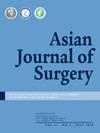术中出血对 II 至 III 期结直肠癌术后腹膜复发的临床影响。
IF 3.5
3区 医学
Q1 SURGERY
引用次数: 0
摘要
背景:本研究旨在探讨接受结直肠癌手术的II期至III期患者腹膜复发(PR)的风险因素:本研究旨在调查接受结直肠手术的II期至III期结直肠癌患者腹膜复发(PR)的风险因素:该研究对 232 名接受结直肠手术的 II 至 III 期结直肠癌患者进行了回顾性研究。通过单变量和多变量分析确定PR的风险因素:PR的总发生率为8.2%(19/232)。单变量 Cox 回归分析表明,癌胚抗原(CEA)水平越高(P = 0.039),碳水化合物抗原 19-9(CA19-9)水平越高(P我们的研究结果表明,组织学类型和术中出血是接受结直肠癌手术治疗的 II 至 III 期结直肠癌患者发生 PR 的风险因素。尤其是腹膜复发与术中出血增加有关。本文章由计算机程序翻译,如有差异,请以英文原文为准。
The clinical impact of intraoperative bleeding on peritoneal recurrence after surgery for stage II to III colorectal cancer
Background
This study aimed to investigate the risk factors for peritoneal recurrence (PR) in patients with stage II to III colorectal cancer who underwent colorectal surgery.
Methods
A retrospective study was conducted on 232 patients who underwent colorectal surgery for stage II to III colorectal cancer. Univariate and multivariate analyses were performed to determine risk factors for PR.
Results
The overall incidence of PR was 8.2 % (19/232). A univariate Cox regression analysis showed that a higher level of carcinoembryonic antigen (CEA) (P = 0.039), higher levels of carbohydrate antigen 19–9 (CA19-9) (P < 0.001), preoperative bowel obstruction (P = 0.011), tumor invasion of T4 category (P = 0.019), lymph node metastasis (P = 0.016), poorly differentiated, mucinous or signet-ring histological type (P = 0.010), larger amount of intraoperative bleeding (P = 0.002), R1 resection (P = 0.003), anastomotic leakage Clavien-Dindo classification (CD) ≥2 (P = 0.018), longer postoperative stay (P = 0.002), and recurrence of other organs preceding disseminated recurrence (P = 0.004) were observed significantly more frequently in patients with PR than in patients without PR. A multivariate Cox regression analysis revealed that poorly differentiated, mucinous, or signet-ring histological type (HR: 5.067, 95 % CI: 1.192–21.534, P = 0.028) and intraoperative bleeding (HR: 1.003, 95 % CI: 1.000–1.005, P = 0.017) were independent risk factors for PR. Peritoneal recurrence-free survival curves generated using the Kaplan-Meier method gradually worsened with increasing intraoperative bleeding (P < 0.001). In addition, the sub-analyses between stage II and stage III and between ≤ cT3 and cT4 also demonstrated that peritoneal recurrence-free survival worsened with increasing intraoperative bleeding.
Conclusions
Our findings suggest that histological type, and intraoperative bleeding are risk factors for PR in patients who undergo colorectal surgery for stage II to III colorectal cancer. In particular, peritoneal recurrence is associated with increased intraoperative bleeding.
求助全文
通过发布文献求助,成功后即可免费获取论文全文。
去求助
来源期刊

Asian Journal of Surgery
医学-外科
CiteScore
3.60
自引率
31.40%
发文量
1589
审稿时长
33 days
期刊介绍:
Asian Journal of Surgery, launched in 1978, is the official peer-reviewed open access journal of the Asian Surgical Association, the Taiwan Robotic Surgery Association, and the Taiwan Society of Coloproctology. The Journal is published monthly by Elsevier and is indexed in SCIE, Medline, ScienceDirect, Scopus, Embase, Current Contents, PubMed, Current Abstracts, BioEngineering Abstracts, SIIC Data Bases, CAB Abstracts, and CAB Health.
ASJSUR has a growing reputation as an important medium for the dissemination of cutting-edge developments in surgery and its related disciplines in the Asia-Pacific region and beyond. Studies on state-of-the-art surgical innovations across the entire spectrum of clinical and experimental surgery are particularly welcome.
The journal publishes original articles, review articles, and case reports that are of exceptional and unique importance. The journal publishes original articles, review articles, and case reports that are of exceptional and unique importance.
 求助内容:
求助内容: 应助结果提醒方式:
应助结果提醒方式:


